Nobel Project’s End-of-2021 Zoom Bash Recaps Learning, Honors Students
February 1, 2022
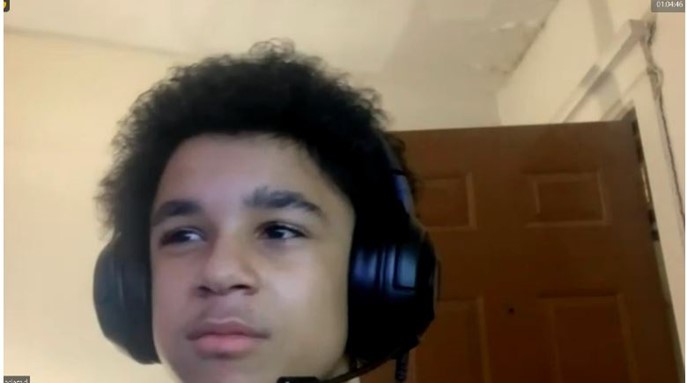
Nobel Scholar Adam DeLong participates in a Saturday Zoom session. (Image courtesy of Ava Meux.)
The STEM Illinois Nobel Project held a special, end-of-the-year Zoom event celebrating its participating students’ achievements on Saturday, November 19, 2021. Showing up for the celebration were many of the roughly 78 Nobel Scholars—middle through high school students (and some of their parents)—who, over the past year, participated in one, or many, of the project’s Saturday Zoom outreach sessions. Part of the Chancellor’s STEM Illinois public engagement initiative, the Nobel Project, begun in fall 2020, has sought to expose participants to Computer Science (CS), CS-related areas, Community Health, Medicine, and even some sociology.
Just what is the Nobel Project? The brainchild of Professor Ruby Mendenhall, who heads up the program, it seeks “to give young people, especially young people of color, unprecedented access to these fields,” she explains, by giving them “tools where they can do life-changing, society-changing things.”
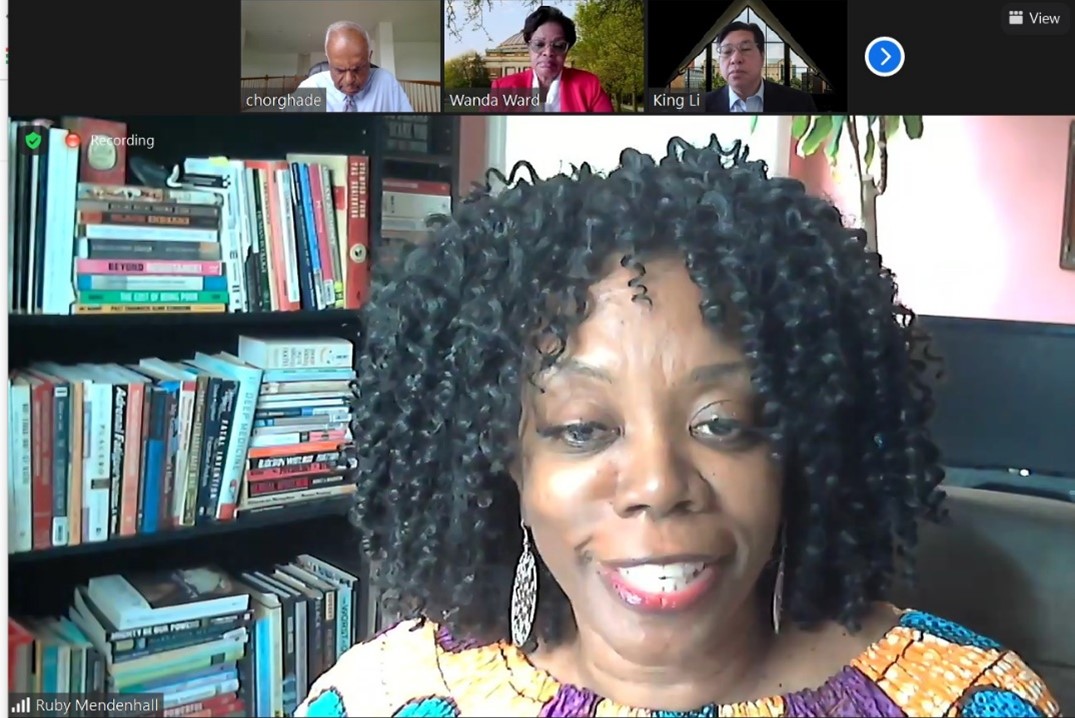 Ruby Mendenhall interacts with the participants during the end-of-year Zoom event.
Ruby Mendenhall interacts with the participants during the end-of-year Zoom event.The program provides training and mentoring which enables students to tackle hands-on projects in the various fields addressed. Its long-term goal is to support and follow the youngsters from middle school through high school, college, and even into adulthood. The November 19th event celebrated a milestone—the students’ achievements during the project’s inaugural year.
Also present at the virtual event, besides students, were key folks who had administrated or contributed to the outreach. MCing the event was Professor Ruby Mendenhall, Associate Dean for Diversity and Democratization of Health Innovation at the Carle Illinois College of Medicine (CIMED) and the Liberal Arts and Sciences Dallenbauch Professor (African-American Studies and Sociology). Also present virtually were a number of the 70+ supporting partners, including Illinois staff and students and community partners, who made the program possible.
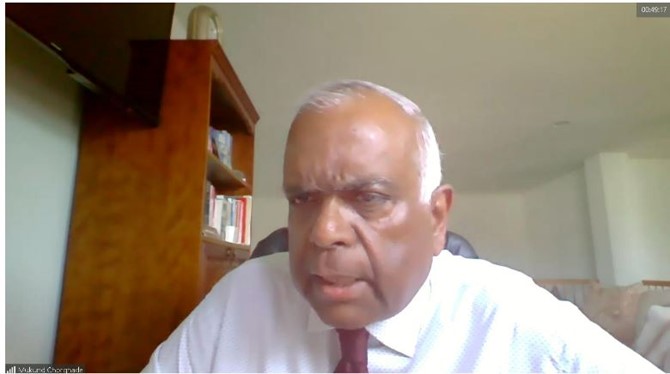
Mukund Chorghade, Adjunct Faculty at the College of Medicine. (Image courtesy of Ava Meux.)
Mendenhall began the day’s program with a welcome and acknowledgement of the many supporters of the Nobel Project, including the Office of the Chancellor and the National Science Foundation, the main sources of funding, Carle Illinois College of Medicine (CIMed), as well as other groups and individuals who had provided support throughout the year. “I am very grateful for your genius,” Mendenhall acknowledged during her remarks, “for your talent that you poured into this program.”
Also giving brief presentations were several key contributors to the program. For example, commending the scholars for their hard work and introducing Nobel Laureate Richard Roberts was Mukund Chorghade, Adjunct Faculty at the College of Medicine.
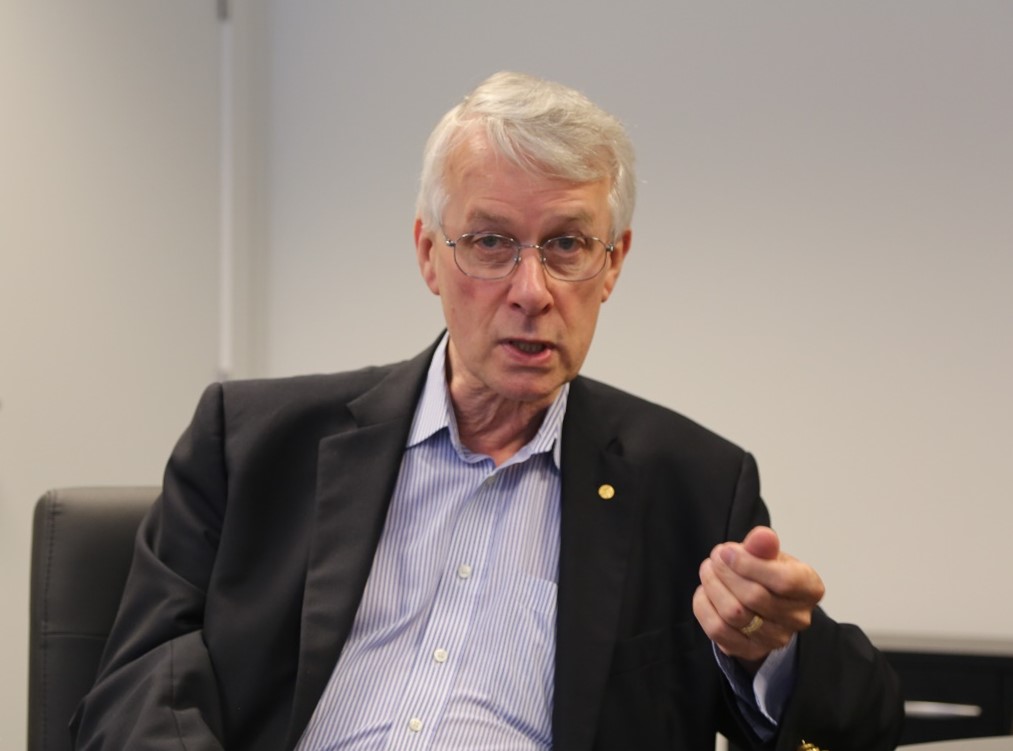
Nobel Laureate Richard Roberts. (Image courtesy of www.euractiv.com.)
Nobel Laureate Roberts, who won the 1993 Nobel Prize in Physiology or Medicine, honored eight students for their achievements with a letter written by the project’s two Nobel Laureate partners. (The other Nobel Laureate, Robert Grubbs, who won the Nobel Prize in Chemistry in 2005, was unable to attend the end-of-the-year event but sent his regards to the students.)
Students being so honored included Adam DeLong, who combined computing with music during his oral history project, plus completed the Community Health Worker Certification program;
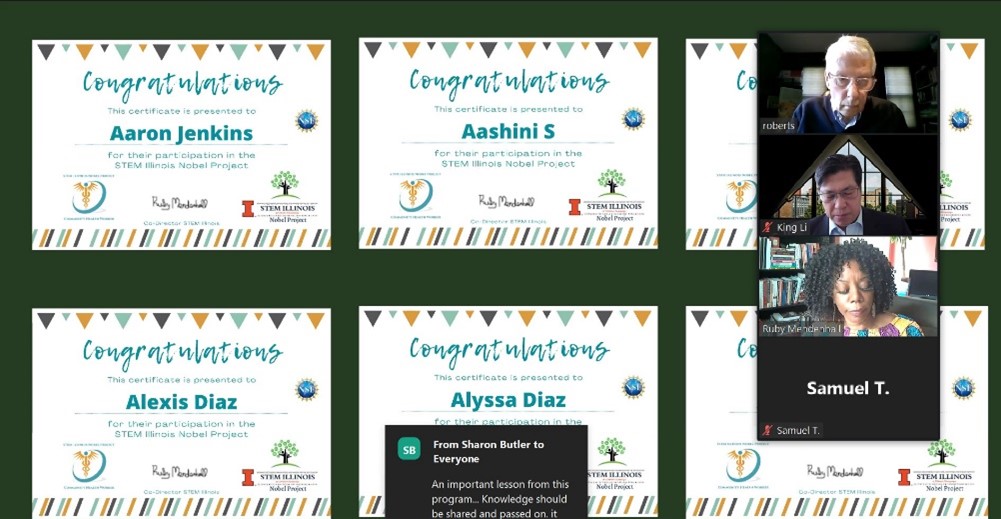
Certificates awarded to all the Nobel Scholars who participated during the first year of the Nobel Project.
Anllely Rivas, who did problem solving with an Arduino microcontroller; Brianna White, who did an oral history project, Arduino coding, and helped to design a gardening robot; Diana Rivas, for her GIS mapping component, Arduino programming, and oral history project done in Spanish;
Genisis Walker, for doing Python Coding with Cyber GISX; Monsol, for the farming robot, “Tin Man,” that he helped design and displayed at the State Fair in Springfield; Saif Williams, who created exemplary Minecraft math videos, coded using Scratch, and worked with the Discord server; and Siri Polk, who used Scratch to design a gardening robot, and created a community map using Python.
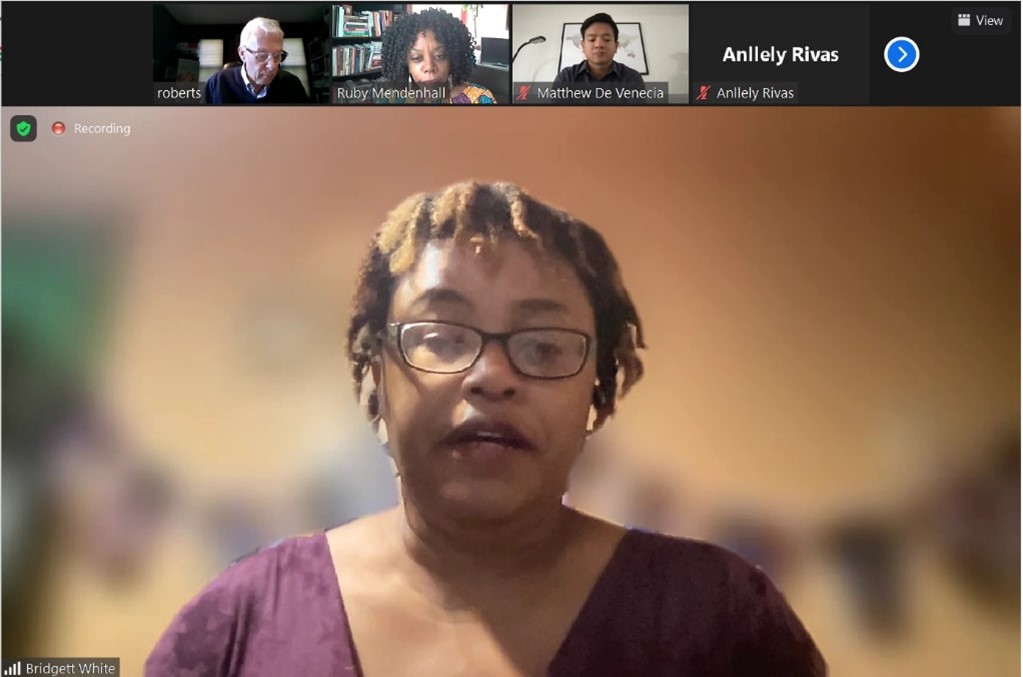
A parent of one of the Scholars, Bridgett White, shares what having her daughter participate in the project has meant to her.
Malik Muhammad also received a letter for being the youngest winner of the Health Make-a-thon and his Scratch coding.
During these award presentations, Brianna White’s mother, Bridgett White, shared about the Project from a parent’s perspective:
“This is such a great exposure for our children, especially children of color who usually don’t get these types of opportunities to be exposed to STEM.”
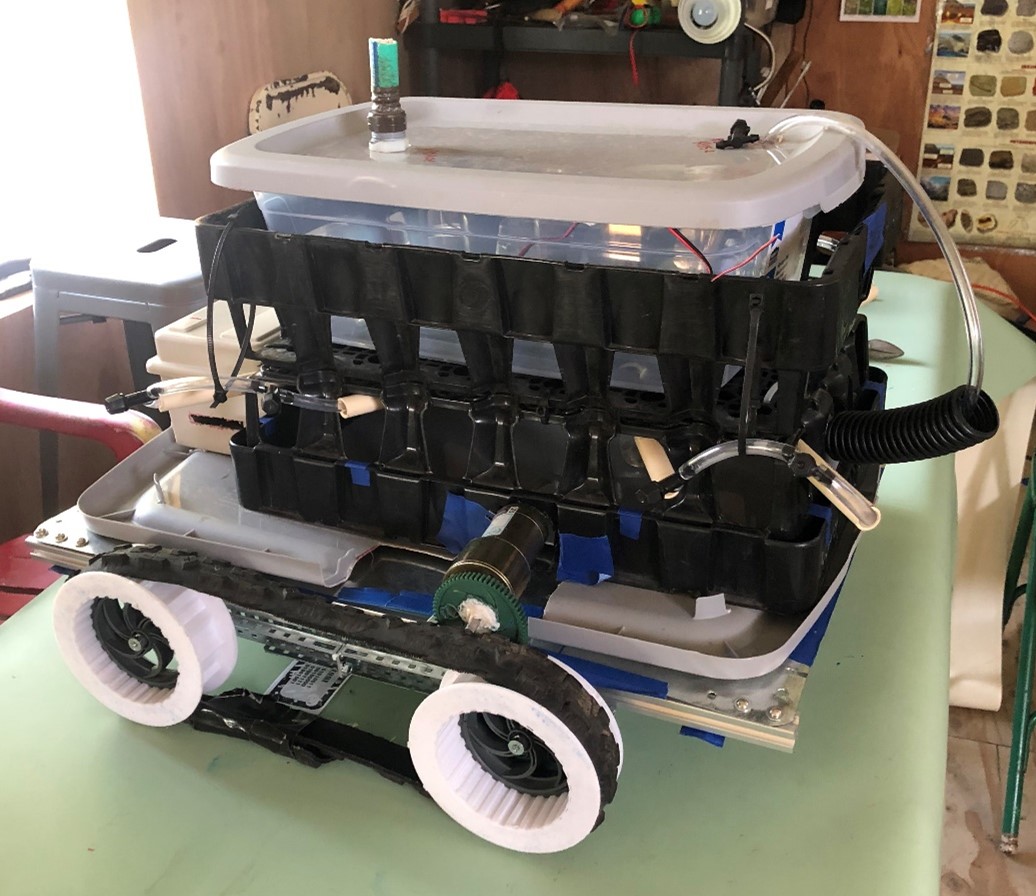
The Tin Man Farm Bot created by a team of Nobel Scholars. (Image courtesy of Mathew De Venecia.)
Nobel Scholar Monsol, who helped create “Tin Man,” indicated that they had named it after Tin Man in the Wizard of Oz, and why. “We decided we would give this robot a heart and a brain through the coding and engineering skills we had learned,” he said, reporting that the robot’s power source was its heart and that the computer that runs the robot was its brain. Monsol claims exhibiting Tin Man at the Illinois State Fair was not only fun, but they learned even more about making their robot more efficient.
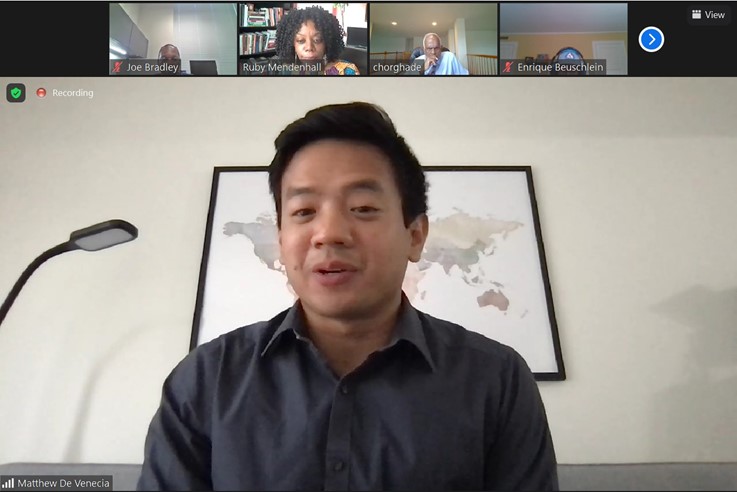
Mathew De Venecia, who helped to administrate the project plus instruct the scholars on several topics helps present awards during the Zoom event.
Illinois alumnus Matthew De Venecia, who helped oversee the team, reports: “They did some really great work, and I’m proud of everything they accomplished.”
After making the presentations, Richard Roberts gave students this advice: “Find the subject you’re most passionate about and make a career of it. But if, along the way, you find something even more exciting, do not hesitate to switch” He backed up this advice by describing the path he’d taken and how a “switch” he had made resulted in his Nobel-Prize-winning research.
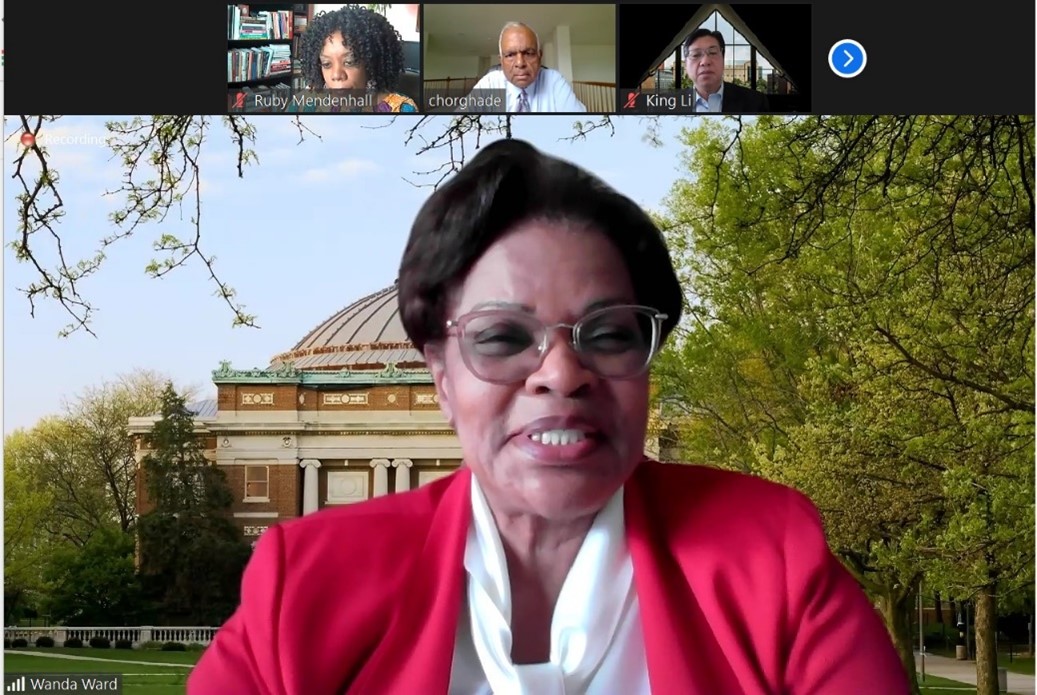
Executive Associate Chancellor Wanda Ward encourages the Nobel Scholars during the end-of-the-hear Zoom event.
Representing the Chancellor’s office, Executive Associate Chancellor Wanda Ward, who shared the Chancellor’s big vision regarding public engagement, called the Nobel Project, “an extraordinarily creative game-changer in the lives of these talented students into whom you and your team are pouring the best of the STEM enterprise, in term of the activities…in terms of the globally recognized, most preeminent scientists in their respective fields, and the full support and access to the extraordinary array of assets that the University of Illinois brings to bear into their futures.”
She also shared an apropos quote from Dr. Benjamin E. Mays, president of Morehouse College: “The tragedy in life does not lie in not reaching your goal; the tragedy lies in having no goal to reach,” then went on to encourage the Nobel Scholars, saying: “This is a big deal! By participating in the inaugural year, you are inherently serving as trailblazers in one of UIUC’s student, STEM-enriched programs,” then encouraged them to “Reach for your stars; walk around with your head held high. Be proud, and never let anyone or anything keep you from achieving your dreams.”
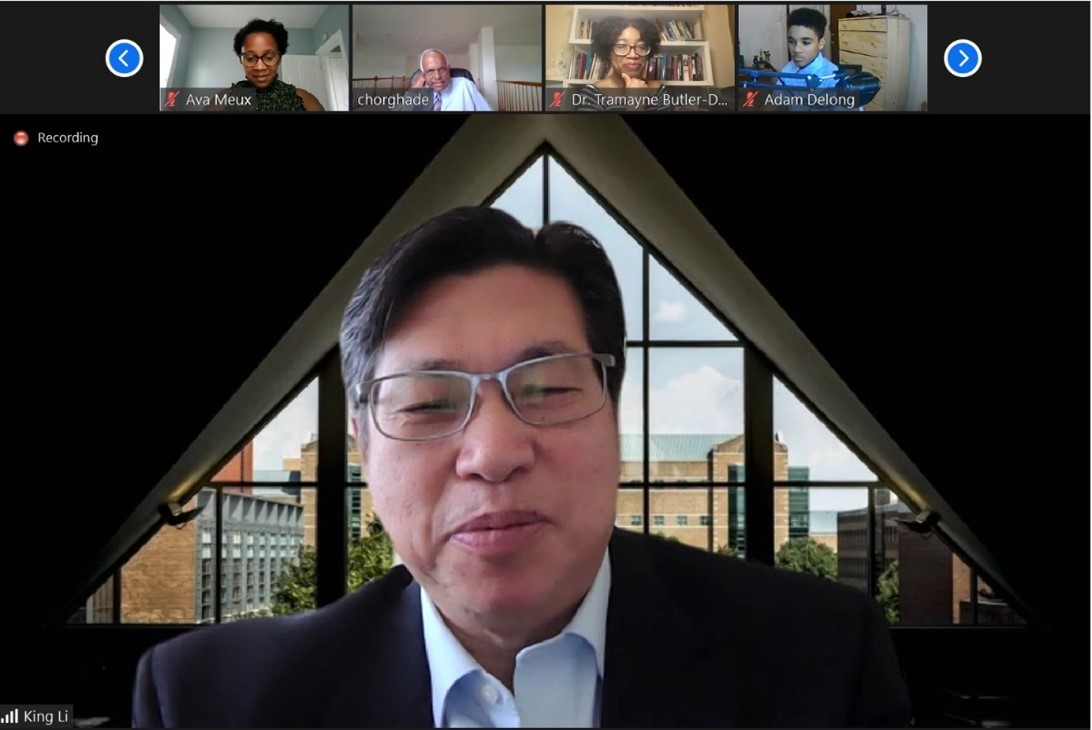
The Dean of the Carle Illinois College of Medicine, King Li, shares about CIMed's resources available to students interested in pursuing the College’s unique emphasis on engineering and medicine.
Also sharing a few words was Dr. King Li, Dean of the Carle Illinois College of Medicine who reported that CIMED’s goals were “to leverage technology to make medicine at higher quality, lower cost, more accessible, and more equitable.” He also shared how students with limited resources who are interested in STEM/ medicine can take advantage of the University’s Pathway program to an undergraduate degree in STEM, and even the College of Medicine.
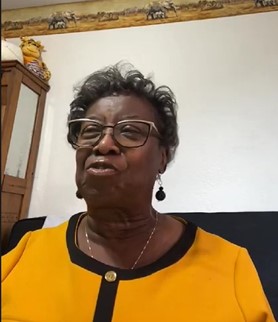
Barbara Gillespie of the NAACP encourages the Nobel Scholars during the event.
Dr. Barbara Gillespie of the NAACP and also the ACT-SO (Academic Cultural, Technological, and Scientific Olympics) program shared, “Our partnership with STEM Illinois is truly making a difference and giving our youth a competitive edge as they optimistically move forward.” She closed with some pithy advice for students: “Believe in yourself; stay strong; never give up; be grateful; work hard; stay humble; be kind; and keep smiling!”
Helping Mendenhall MC the celebration were several staff members who have been integral to the program: Matthew De Venecia, Lea Hill, and Ava Meux, who recognized the 70+ community partners, such as ChiSE project’s Kenneth Hill, whom Mendenhall termed part of the project’s ecosystem, which she says also included medical students from CIMED.
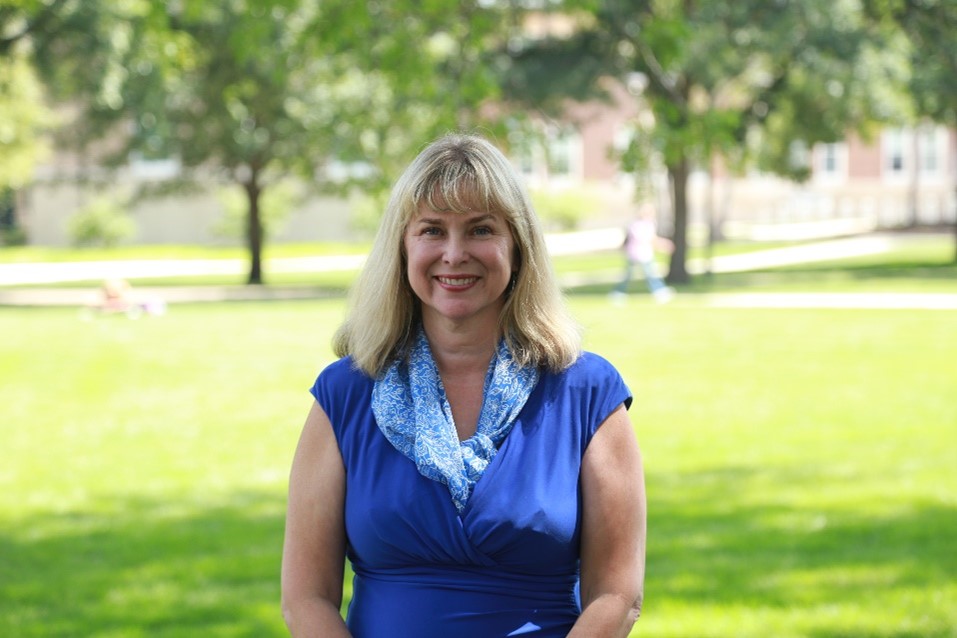
Jessica’s Breitbarth of the CIMED Pathways Program. (Image courtesy of Rebecca Schultz.)
Representing CIMED and its Pathways program was Jessica Breitbarth, who gave students additional advice: “Take the lessons that you’ve learned today, whether it’s lessons in science, or mathematics, or computing, and pay it forward, and we will have a much better community, and a much richer one.
Samyra Leonard, who oversees the project’s Community Health Worker Certification component, presented during the celebration as well, explaining what community health workers are and do. (A detailed description of this program follows.)
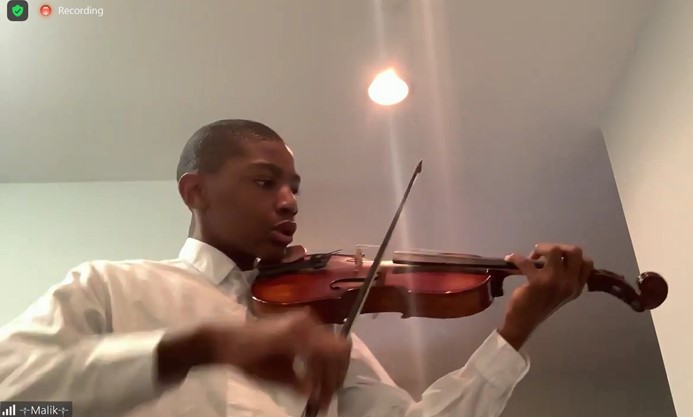
Nobel Scholar Malik Muhammad shares a musical selection during the event.
During the event, two scholars also shared musical pieces. Playing a violin solo was Malik Muhammad, who, along with his father, won a $10,000 award at the April 2021 Health Make-a-thon to study if listening to live classical music decreases stress in the family members of gunshot victims and COVID patients in waiting rooms at hospitals. Sharing a trombone solo of jazz blues, the Joe Avery Blues was Samuel Troconis who had actually composed some of the solos himself.
Nobel Project Components
The November 19th Saturday celebration was one of the 42 Saturdays on which the Project has held activities since its inception (they just took time off for holidays, such as Thanksgiving break.) Saturday Zoom sessions were the project’s primary interaction time, where students received instruction, heard inspirational talks, and presented their projects.
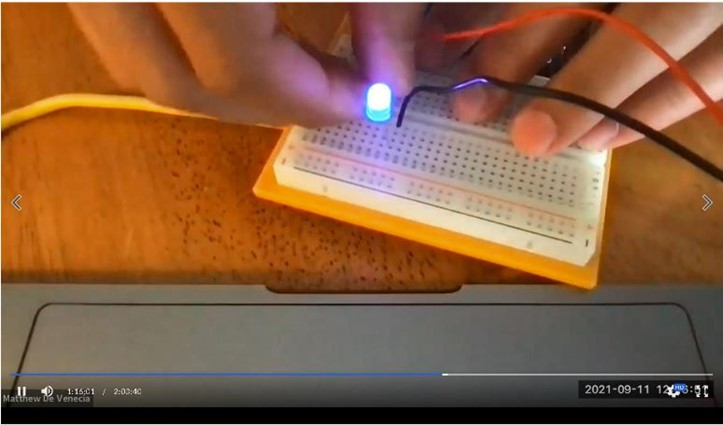
During one of the year's activities, a Nobel Scholar lights up an LED light while programming an Arduino. (Image courtesy of Ava Meux.)
During one of the year's activities, a Nobel Scholar lights up an LED light while programming an Arduino. (Image courtesy of Ava Meux.)
Thursday meetings enabled students to practice skills they’d learned and allowed parents to ask questions, etc. Community Health training was held on Sundays, with family workshops on Thursdays.
As noted above, the Nobel Scholars were exposed to a range of disciplines over the last year. They received training or learned skills in those areas, then completed individual or group projects to put those skills into practice. For instance, students did CS-related projects in a number of fields. Each student received an Arduino, a programmable micro-controller that allows the use of switches to automate devices. Students also had the opportunity to learn coding via Scratch, such as in projects supervised by Matthew De Venecia.
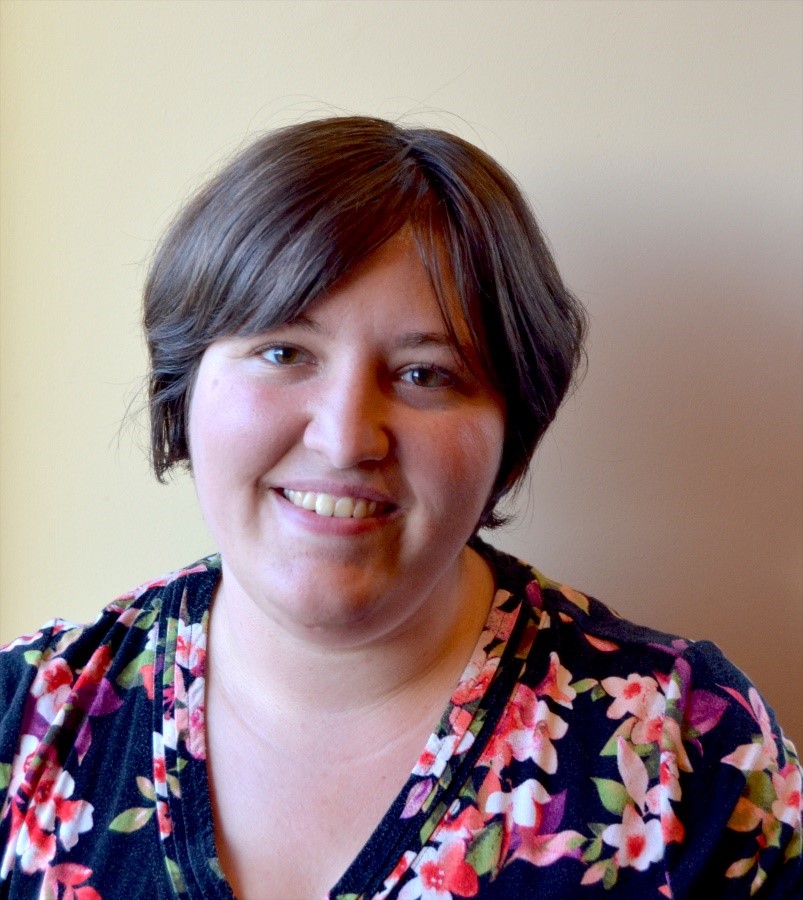
Geography and Geographic Information Science PhD student Becky Vandewalle, who was in charge of Nobel’s Geospatial Fellows program.
In another area emphasizing Geospatial Science, a grant from Geospatial Institute provided the resources to establish Nobel’s Geospatial Fellows program, where kids learned how to use Python coding to read maps and were exposed to the CyberGISX platform. Overseeing this program was Becky Vandewalle, a Geography and Geographic Information Science Department PhD student. As part of her involvement, she wrote a training program on how to use CyberGISX, a platform created and run by the CyberGIS Center for Advanced Digital and Spatial Studies for college students and faculty.
Vandewalle also taught participants how to use basic Python programming language, including Folium, a Python package that makes interactive web maps, plus how to create interactive web maps within Jupyter interactive coding notebooks on CyberGISX. Student projects involved creating COVID-19-related maps about their communities.
Having never “created technical content for such young students before (and such a broad age range!)” Vandewalle “ultimately found the experience rewarding.” Of the entire experience, she was, “very impressed with how well the students were able to start from the very beginning and ended up able to create remarkable maps for their projects! Watching them grasp the material so rapidly and then make it their own was very inspiring.”
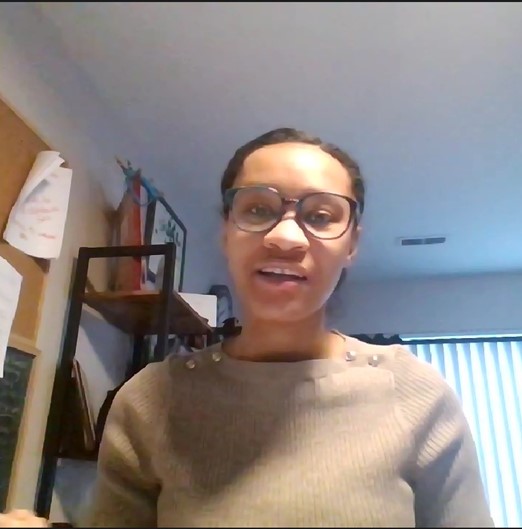
Samyra Leonard of the CU Trauma and Resilience Initiative.
Another broad area of projects addressed was the Community Health Worker Certification component taught by Samyra Leonard, Program Coordinator of the CU Trauma and Resilience Initiative (TRI) with help from Karen Simms (Founding Director of TRI). Eighteen students explored Community Health issues through the program, which used the Morehouse College Community Health curriculum. As part of the community health worker emphasis, students formed teams based on mutual interests to work on various projects ranging from the environment, to nutrition, to community gardening.
Darnell Moore and Siri Polk’s Environmental Justice project involved water, air, and soil quality testing kits (including air quality sensors). To educate more people in their neighborhoods about air and soil quality, the two are writing up their findings which another partner, Tanya Parker, will publish in her Unity in Action magazine. Janaki Devendra, Annika Polk, and Christian Ross developed Nutrition & Wellness Educational Workshops which they presented to the Nobel Scholars via Zoom. In his Beyond the Body project, Adam DeLong’s project involves interviewing people on different topics related to nutrition. Bridgett and Brianna White completed a gardening project: growing watermelons and other fruits/vegetables in the house.
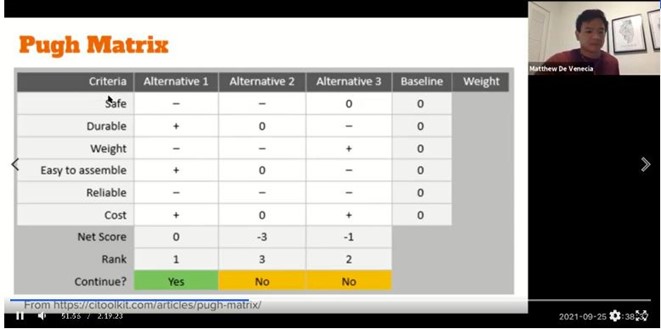
A Pugh Matrix shared by Matthew De Venecia during the FarmBot teaching session this past year. (Image courtesy of Ava Meux.)
One hoped-for project, building Farm Robots (FarmBots), didn’t take place because of a COVID-related delay on the robot kits ordered; however, this didn’t stop one team of young people from Pembroke, who went ahead and built their own farm robot with support from engineer Matthew De Venecia, which even had a name—Tin Man—and which they exhibited at the Illinois State Fair.
To date, four high school students have finished the program and obtained their health worker certificates: Adam DeLong, Janaki Devendra, Annika Polk, and Christian Ross, with several others still working on theirs. Two undergraduates also received their certificates, Wdasie Ayele and Kathy De La Torre.
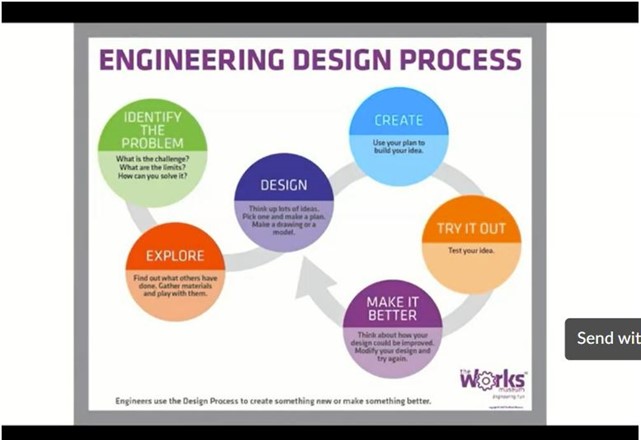
Engineering Design Process shared by Matthew De Venecia during one of the teaching sessions this past year. (Image courtesy of Ava Meux.)
Mendenhall believes students with the Community Health Worker certification are well on their way to health careers should they so choose. For instance, the project enrolled them as members of the Illinois Association of Community Health Workers as well as the National Association of Community Health Workers. “Because we want to socialize them as individuals who are in the health field already…not when they graduate from high school…not when they graduate college…not when they graduate from medical school. They are able to do life-changing health and wellness activities now. That, to me, is why we’re doing it.”
Another Nobel project was related to sociology and history: Oral Histories—how historians (and others) interview people with personal knowledge of past events. Helping with the training were Alvarez Dixon, an Informatics PhD student, and Tanya Parker from Unity in Action magazine, Plus, Parker taught a unit about video editing. Following the training, several scholars conducted interviews of their own with family members. For instance, Adam DeLong, interviewed his mother about his great grandfather and his laundry service business and discovered a great deal of intrigue; Diana Rivera interviewed her Latinx grandmother in Spanish about why she left Mexico and came to the states.
So, Why the Nobel Project?
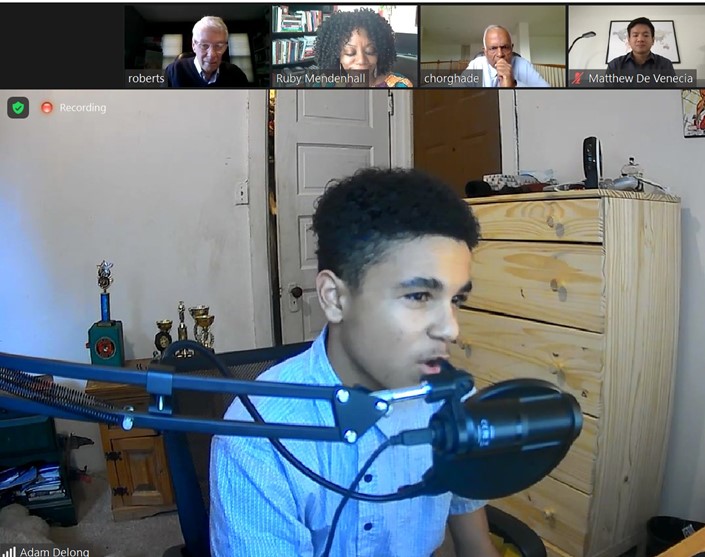
During the Zoom session, Adam DeLong shares about the impact the program had on him personally.
Regarding the need for the Nobel Project, Mendenhall comments: “I think the big question is about the lack of diverse students in computer science, and it really is a field where technology has the potential to transform society.” However, she also believes CS has the potential to reproduce some of today’s social inequality as well, “if you don’t pay attention to the biases that are already baked into it, if you don’t pay attention to who is creating the algorithms and their lived experience, you could miss their blind spots,” she stresses.
While Nobel Laureates Richard Roberts and Robert Grubbs were some key program resources, their contributions to the program are only part of why it was called the Nobel Project. Mendenhall intended it to be a source of inspiration for participating students:
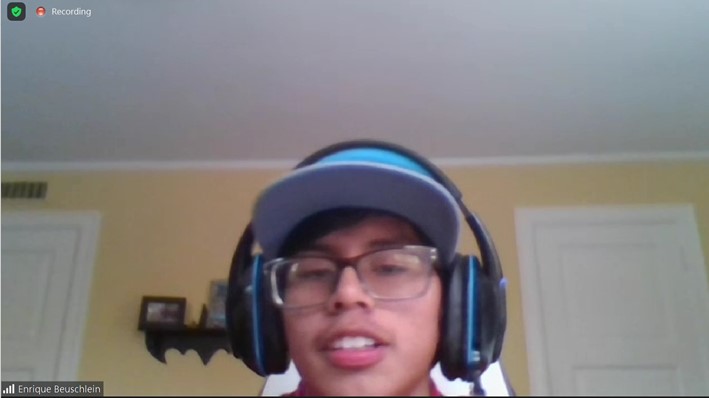
Nobel Scholar Enrique Beuschlein participates in one of the Saturday Zoom sessions.
“So, when I talk about the students as Nobel Scholars…my goal for them is that they will produce things that improve society on the level of a Nobel Laureate...So, I think the Nobel Project is fostering a generation of students, and their families (again, it just can’t be the kids—it’s a whole ecosystem), that can do things at their limit and beyond their limits.”
As alluded to above, another important Nobel Project component is its intergenerational emphasis. “We believe the mother, uncle, sister, brother, cousin has to be in the pathway program in order to ensure that the child goes through and succeeds,” says Mendenhall. “You can’t just work with the child; you have to work with the whole ecosystem.” Thus, parents/family were encouraged to be an integral part of their student’s participation, not only supporting their child’s involvement in activities, but taking part themselves in those designed for family.
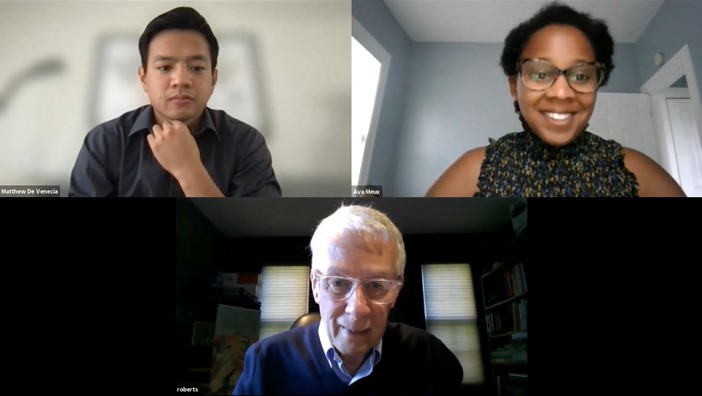
Mathew De Venecia, Ava Meux, Richard Roberts, some key players in the project, who also served as mentors, interact with the Nobel Scholars via Zoom during the final event.
What’s in store in the future for the Nobel Project? For one, over the next year, they plan to involve Nobel Scholars in a flight experiment with NASA astronauts who will grow alfalfa in outer space for supplemental food sources and biofuels. The Nobel Project will also be adding a mentoring component.
“So, our next big goal for next year is to connect them with mentors who will help us to follow them.” Mendenhall says if someone’s passion is using robots for surgery, they want to look around and find who’s doing that and connect them with that person. “So that’s the next thing—to even expand the ecosystem and bring into their lives individuals who can be with them six months, a year, twenty years.”
Mendenhall expresses her appreciation for all her coworkers and partners in the project. “I’m working with a huge team, right? I could not have done this without such an amazing team. So, it is really important to understand that when universities and communities, and schools, and others want to invest in programs that are transformative for young people and their families, they also have to invest in the people who can do the labor, because it’s labor intensive to do this kind of work, and to follow young people over time.”
 Several participants who attended the End-of-Year event via Zoom. Left to right, top to bottom, these include Ava Meux, Richard Roberts, Ruby Mendenhall, Chorghade, Dotty Stumpf, Wanda Ward, King Li, Barbara Gillespie, a Nobel Scholar, and Matthew De Venecia.
Several participants who attended the End-of-Year event via Zoom. Left to right, top to bottom, these include Ava Meux, Richard Roberts, Ruby Mendenhall, Chorghade, Dotty Stumpf, Wanda Ward, King Li, Barbara Gillespie, a Nobel Scholar, and Matthew De Venecia.













.jpg)
















